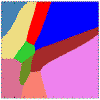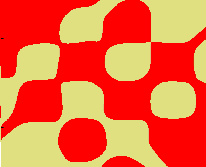SOFTWARE TOOLS
LNKnet
Documentation includes a short quick-start guide, a long 200-page user's guide, and UNIX man pages for the many LNKnet commands.
Downloading LNKnet
The version of LNKnet that includes support vector machines is not yet in the public domain but will be released in the future.LNKnet software was originally developed under Sun Microsystems Solaris 2.5.1 (SunOS 5.5.1) UNIX operating system and then ported to Solaris 2.6 (SunOS 5.6) under SUN Open Windows. It was recently ported to Red Hat Linux and to Cygwin to run under the Windows operating system.
Source code is available both for individual programs (e.g. mlp_lnk, svm_lnk) and for the graphical user interface.
The following four gzipped tar files contain executables, man pages, documentation (the Quick-Start Guide and the LNKnet User's Guide), and sample data sets for Solaris, Red Hat Linux, and Cygwin:
LNKnet executables for Solaris with Sample Data and Man Pages - gzipped tar file (22 Mbytes)
LNKnet executables for Red Hat Linux with Sample Data and Man Pages - gzipped tar file (22 Mbytes)
LNKnet executables for Cygwin with Sample Data and Man Pages - gzipped tar file (23 Mbytes)
LNKnet now uses the GNU Autoconf tool to simplify compiling LNKnet on different host platforms. The following gzipped tar file uses Autoconf and contains source code for all LNKnet programs, man pages, documentation, and sample data sets:
Source Code - gzipped tar file (9 Mbytes)
The following two pdf files contain the Quick-Start Guide and the LNKnet User's Guide:
Quick-Start Guide - pdf file (0.2 Mbytes)
Users-Guide - pdf file (4.3 Mbytes)
Methods Used to Access LNKnet Classifiers

The above image shows three different methods are used to access LNKnet pattern classification software. The first and most popular approach is to take advantage of the high-level graphical user interface (GUI) to run experiments. This GUI allows a non-programmer who knows at least a little about pattern classification to run experiments by pressing buttons and making selections using a mouse. A second approach, used to create automatic batch jobs, is to run LNKnet classification driver programs from the UNIX command line or in shell scripts. A third popular approach, used by C-programmers to embed LNKnet classifiers in application programs, is to use the LNKnet GUI to automatically produce C source code which implements a trained classifier. This C-code can be copied into an application program and used with little knowledge concerning details of the classifier being used. These three interfaces have been used successfully for speech recognition, talker identification, medical risk prediction, chemical analysis, and other problems at MIT Lincoln Laboratory and many other government labs and Universities. The GUI has substantially reduced the time required to run classification experiments and explore new data sets.
Algorithms Included in LNKnet
| Supervised Training | Combine Unsupervised- Supervised Training | Unsupervised Training (Clustering) | |
| Neural Network Algorithms |
Back-Propagation (MLP) Hypersphere Classifier Perceptron Committee |
Radial Basis Function (RBF) Incremental RBF Learning Vector Quantizer (LVQ) Nearest Cluster Classifier Fuzzy ARTMap Classifier |
|
| Statistical and Machine Learning Algorithms |
Gaussian Linear Discriminant Gaussian Quadratic K-Nearest Neighbor Binary Decision Treee Parzen Window Histogram Naive Bayes Support Vector Machine |
Gaussian Mixture Classifier - Diagonal/Full Covariance - Tied/Per-Class Centers |
K-Means Clustering EM Clustering Leader Clustering Random Clustering |
| Feature Selection Algorithms | Linear Discriminant (LDA) Forward/Backward Search |
Principal Components (PCA) |
The above table shows the most comonly used LNKnet neural network, statistical, and machine learning classification and clustering algorithms and feature selection algorithms. Classification algorithms include: support vector machine classifiers, naive Bayesian classifiers, multi-layer sigmoid nets (multi-layer perceptrons) with squared-error, cross-entropy, maximum likelihood, and classification-figure-of-merit cost functions; hypersphere classifiers (sometimes called RCE classifiers); unimodal Gaussian classifier with full/diagonal and grand/per-class covariance matrices (linear discriminant and quadratic discriminant classifiers); k-nearest neighbor classifier, condensed k-nearest neighbor classifier; binary decision tree (similar to CART); radial basis function classifier, incremental adaptive center and variance radial basis function classifier with four cost functions; four versions of learning vector quantizer classifiers; nearest cluster classifier, perceptron convergence procedure; Parzen widow classifier, histogram classifier, and Gaussian mixture classifier with full/ diagonal and tied per-class covariance matrices. Clustering algorithms include: leader clustering (similar to ART); k-means clustering with binary splitting initialization; and Gaussian mixture clustering with binary splitting initialization. Feature reduction algorithms include principal components analysis and canonical linear discriminant analysis. Feature selection algorithms available with all classifiers include forward and backward search feature selection. In addition, n-fold cross validation is available with all classifiers and C source code is produced which replicates any trained classifier.
 |
LNKnet Graphics and Plots |
 |
LNKnet produces a wide variety of plots and tables. The plot on the above left shows decision regions for a vowel classification problem and the plot on the right shows decision regions for a checkboard classification problem that uses a support vector machine for classification. Plots produced include 2-D decision region plots, output profile and histogram plots, structure plots describing the computing architecture, and plots illustrating how the error rate and other cost functions vary with time. In addition, after an experiment is run, outputs include confusion matrices, tables of the error rate for each class, and overall error rates.
Questions and Comments
email: KUKOLICH@LL.MIT.EDU
top of page